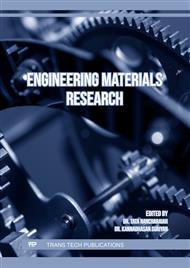[1]
J. Toribio, F.J. Ayaso, B. Gonzalez, Role of non-metallic inclusions in the fracture behavior of cold drawn pearlitic steel, metal, 11 (2021) 962
DOI: 10.3390/met11060962
Google Scholar
[2]
A. Costa e Silva, The effects of non-metallic inclusions on properties relevant to the performance of steel in structural and mechanical applications, Journal of Materials Research and Technology, 8 (2019) 2408-2422
DOI: 10.1016/j.jmrt.2019.01.009
Google Scholar
[3]
J.H. Park, I.H. Jung, H.G. Lee, Dissolution behavior of Al2O3 and MgO inclusions in the CaO– Al2O3–SiO2 slags: formation of ring-like structure of Mg Al2O3 and Ca2SiO4 around MgO inclusions, ISIJ International, 46 (2006) 1626-1634
DOI: 10.2355/isijinternational.46.1626
Google Scholar
[4]
P.R. Scheller, Q. Shu, Inclusion Development in Steel During Ladle Metallurgical Treatment - A Process Simulation Model – Part: Industrial Validation, Steel Research International, 85 (2014) 1310-1316. http://doi.prg/
DOI: 10.1002/srin.201300375
Google Scholar
[5]
Y. Ren, L. Zhang, W. Fang, Effect of addition of Al-based slag deoxidizer on MgO.Al2O3 inclusions in 3Si-Fe steels, Metallurgical Research & Technology, 114 (2017) Article No. 108
DOI: 10.1051/metal/2016043
Google Scholar
[6]
K Steneholm, M Andersson, A Tilliander, P.G. Jönsson, Removal of hydrogen, nitrogen and sulphur from tool steel during vacuum degassing, Ironmaking & Steelmaking, 40 (2013) 199-205
DOI: 10.1179/1743281212Y.0000000029
Google Scholar
[7]
P. Singha, S. Yadav, A.K. Shukla, Ladle Steelmaking Processes Using FactSage and Its Macro Facility, Proceedings of the Iron & Steel Technology Conference, 16–18 May 2022, Pittsburgh, Pa., USA, 2022, 1723-1728
DOI: 10.33313/386/203
Google Scholar
[8]
L. Wang, S. Yang, J. Li, T. Wu, W. Liu, J. Xiong, Improving Cleanliness of 95CrMo Drill Rod Steel by Slag Refining, Metallurgical and Materials Transactions B, 47 (2016) 99-107
DOI: 10.1007/s11663-015-0481-0
Google Scholar
[9]
J. Strandh, K. Nakajima, R. Eriksson, P. Jonsson, Solid Inclusion Transfer at a Steel-Slag Interface with Focus on Tundish Conditions, ISIJ International, 45 (2005) 1597-1606
DOI: 10.2355/isijinternational.45.1597
Google Scholar
[10]
X.F. Zhang, W.J. Lu and R.S. Qin, Removal of MnS inclusions in molten steel using electropulsing, Scripta Materialia, 69 (2013) 453-456
DOI: 10.1016/j.scriptamat.2013.05.033
Google Scholar
[11]
L.O. Uhrus, Through Hardening Steels for Ball Bearings- Effect of Inclusions on Endurance, Iron Steel Inst. Spec. Rep. 77 (1963) 104-109.
Google Scholar
[12]
Y. Murakami, Effects of Small Defects and Nonmetallic Inclusions on the Fatigue Strength of Metals, JSME International Journal, 32 (1989) 167-180
DOI: 10.1299/jsmea1988.32.2_167
Google Scholar
[13]
J.C. Pang, S.X. Li, Z.G. Wang, Z.F. Zhang, General relation between tensile strength and fatigue strength of metallic materials, Materials Science & Engineering A, 564 (2013) 331-341
DOI: 10.1016/j.msea.2012.11.103
Google Scholar
[14]
A. Patra, Oxide Dispersion Strengthened Refractory Alloys - 1st Edition, CRC Press. (2022)
Google Scholar
[15]
G. Wang, L. Huang, X. Zhan, L. Tan, Z. Qin, W. He, F. Liu, Strength-hardness correlations of thermal-exposed oxide dispersion strengthened nickel-based superalloy with different grain size distributions, Materials Characterization, 178 (2021) Article No. 111178
DOI: 10.1016/j.matchar.2021.111178
Google Scholar
[16]
L. Raman, K. Gothandapani, B.S. Murty, Austenitic Oxide Dispersion Strengthened Steels: A Review, Defence Science Journal, 66 (2016) 316-322
DOI: 10.14429/dsj.66.10205
Google Scholar
[17]
W. Weibull, A Statistical Distribution Function of Wide Applicability, ASME Journal of Applied Mechanics, 18 (1951) 293-297
DOI: 10.1115/1.4010337
Google Scholar


